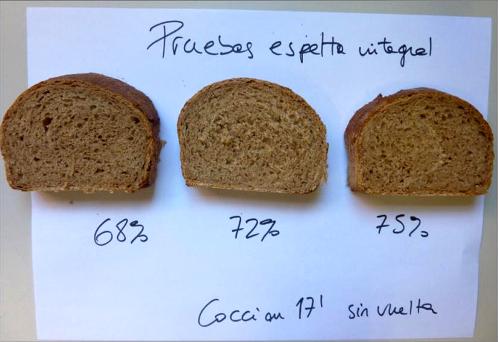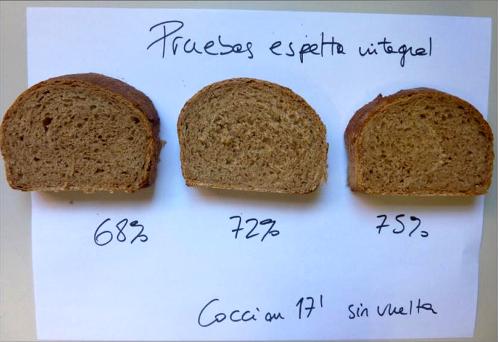In order to study the influence of wheat varieties in sensory quality of bread, the research group of Breeding Plants from Universidad Politécnica de Madrid (UPM) has developed the sensory profile of five different wheat varieties three bread wheat (Triticum aestivum ssp. vulgare L.) and two spelt wheat (T. aestivum ssp. spelta) and has found significant differences among them. This result has led to consider the sensory properties as another criterion of selection for future breeding wheat works. Besides, they have also designed a training protocol for the panel of judges involved in the bread tastings that would improve the reliability of these tastings.

Spelt wheat is an ancient grain that has regained a great interest over the last 20 years because of its nutritional potential and its adaptation to organic farming conditions. In order to study the sensorial differences between the bread made with this type of wheat and the one made with traditional wheat, researchers at UPM have used five samples of different grain, two grains of spelt and three of baker wheat. The whole study was designed to make the breads from these five grain samples and was considered “monovarietal”.

Thus, all grains came from the same place (Vitoria), from the same harvest (2010/2011) and from organic farming. Besides, all samples were grinded with the same grinding diagram and with their flour they proceeded to make bread following the same protocol adding sourdough to achieve the best quality in the final product.
After achieving the five types of breads, researchers developed the sensory profile. A panel of expert judges was trained for bread tastings, and by using this profile the main relative attributes to this analysis: aroma, appearance, texture and taste were determined.
Firstly, researchers found significant differences among the types of bread, both in the alveoli structure and in the elasticity of bread crumbs made with spelt wheat and bread made with common wheat. Secondly, they found differences in the attributes of smell and taste.
Today, sensory properties are not included as quality parameters for works of selection of new wheat varieties. However, thanks to these results, researchers from UPM suggest including these sensory properties since they have a great relevance in the outcome of the changing process from grain into bread.
Besides, they suggest a protocol for the selection, training, and verification of an expert judge panel to assess the bread quality. This will positively affect on the results that later on will be transferred to the consumers.
CALLEJO MJ, VARGAS-KOSTIUK ME, RODRÍGUEZ-QUIJANO M (2015). “Selection, training and validation process of a sensory panel for bread analysis: Influence of cultivar on the quality of breads made from common wheat and spelt wheat”. Journal of Cereal Science, 61: 55-62, JAN 2015.
Propiedades sensoriales, un criterio más para la mejora genética del trigo
Un estudio de la UPM pone de manifiesto que los panes procedentes de determinadas variedades de trigos espelta tienen propiedades sensoriales diferenciadas que podrían considerarse en futuros trabajos de mejora genética.
Con el objetivo de estudiar la influencia de la variedad de trigo en la calidad sensorial del pan, el grupo de investigación de Mejora Genética de Plantas de la Universidad Politécnica de Madrid (UPM) ha elaborado el perfil sensorial de cinco variedades de trigo diferentes de trigo panadero (Triticum aestivum ssp. vulgare L.) y dos de trigo espelta (T. aestivum ssp.spelta) y han encontrado diferencias significativas entre ellos, lo que les ha llevado a proponer la conveniencia de considerar las propiedades sensoriales como un criterio más de selección en futuros trabajos de mejora genética del trigo. Además, durante el proceso, han diseñado un protocolo de entrenamiento para los paneles de jueces que intervienen en las catas de pan que mejorará la fiabilidad del resultado de las mismas.

El trigo espelta es un cereal ancestral que ha recobrado un gran interés en los últimos 20 años debido a su potencial nutricional y a que se adapta muy bien a condiciones de cultivo ecológico. Para estudiar las diferencias sensoriales entre el pan elaborado con este tipo de trigo y el tradicional trigo panadero, investigadores de la UPM han utilizado cinco muestras de grano diferentes, dos de espelta y tres de trigo panadero. Todo el estudio se diseñó para que los panes elaborados a partir de estas cinco muestras de grano pudieran considerarse “monovarietales”. Para ello, todos los granos procedían del mismo lugar (Vitoria), de la misma cosecha (2010-2011) y de cultivo ecológico. Además, todas las muestras fueron molidas con el mismo diagrama de molienda y con sus harinas se procedió a elaborar el pan siguiendo el mismo protocolo, que incorporaba masa madre para conseguir la mejor calidad en el producto final.

Una vez conseguidos los cinco tipos de panes, se procedió a elaborar su perfil sensorial. Para ello, se entrenó a un panel de jueces expertos en cata de pan y mediante este perfil se determinaron los principales atributos relativos a este tipo de análisis: aroma, apariencia, textura y sabor.
Por un lado, se encontraron diferencias significativas tanto en la estructura de los alveolos como en la elasticidad de la miga de los panes elaborados con espelta comparados con los elaborados con trigos panaderos. Y, por otro, también se hallaron diferencias en los atributos de olor y sabor, siendo uno de los panes elaborados con espelta el que dio lugar a los panes más complejos desde el punto de vista sensorial.
Hasta ahora, las propiedades sensoriales no han sido incluidas como parámetros de calidad en los trabajos de selección de nuevas variedades de trigo. Sin embargo, a partir de los resultados de este nuevo estudio, los investigadores de la UPM proponen que sí lo sean, debido a su importancia en el resultado final del proceso de transformación del grano en pan.
Además, otra de las novedades de este trabajo es la propuesta de un protocolo para la selección, entrenamiento y validación de un panel de jueces expertos que evalúen la calidad de los panes. Esto repercutirá positivamente en los resultados que más tarde se trasladarán a los consumidores.
CALLEJO MJ, VARGAS-KOSTIUK ME, RODRÍGUEZ-QUIJANO M (2015). “Selection, training and validation process of a sensory panel for bread analysis: Influence of cultivar on the quality of breads made from common wheat and spelt wheat”. Journal of Cereal Science, 61: 55-62, JAN 2015.